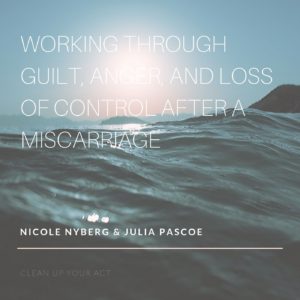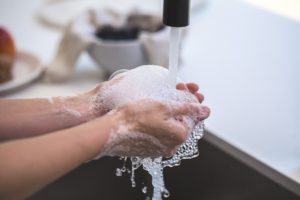Why You Should Switch to an Aluminum-free, Safe Deodorant
I have learned the good, the bad, and the ugly during my transition to safer personal care products. Eventually, I knew that I had to face the deodorant debacle. Many personal care products perform just as well if not better than their unsafe counterparts. But deodorant – we absolutely need it to work and work well! No one wants to walk around paranoid about potential body odor!
Why should we avoid Aluminum-based deodorants?
Clogged Sweat Ducts
Aluminum-based compounds are the active ingredients in antiperspirants. The purpose of the aluminum salts is to temporarily “plug” the sweat ducts. Sweat ducts transport your sweat from your body to your skin’s surface. Aluminum salts actually dissolve and form a chemical reaction with the water to block your sweat. The idea of plugging the sweat ducts to keep the area under your arms dry sounds good in theory, but is it really?
Sweating is your body’s natural way of eliminating heat, toxins, and environmental pollutants that attach to your body – I know I want those out! Once your sweat ducts are plugged, the aluminum in antiperspirant deodorant forces your body to reabsorb all of those toxins – gross! No thank you! Just as you need to breathe, so do your pores! Additionally, clogged pores can lead to acne and other dermatologic problems.
What are other common chemicals we should avoid in deodorant?
Parabens
Parabens are preservatives many companies use to prevent the growth of mold and bacteria in your deodorant or antiperspirant. What’s wrong with parabens? Research has shown that parabens mimic the activity of estrogen in the body’s cells. By mimicking the activity of estrogen, they disrupt your natural hormonal mechanisms. A higher lifetime exposure to estrogen has been shown to increase the risk for breast cancer. Research shows that parabens harm infertility and reproductive organs and may also affect birth outcomes. Parabens are absorbed through the skin and into your body once you are exposed to them in your personal care products.
Phthalates
Phthalates are known endocrine disruptors. They are a colorless, odorless, oily liquids that are added to make plastic flexible and more easy to break. Sadly, they are also added to personal care products to make the fragrances last longer. Phthalate exposure has been linked to hormone disruption, worsening asthma and allergies, increased risk of cancer, miscarriage, birth defects, preterm birth, and low birthweight. The risks are not just unique to women either, phthalates are also linked to interference with male testosterone and can cause irreversible effects on male reproduction.
If that is not scary enough, read HERE for more detailed information on phthalates and why you and your family should avoid them at all costs! Want the quick and dirty? Find a one page phthalate reference guide HERE to assist you and your clean living journey.
Polyethylene Glycol
Polyethylene Glycol (PEGs) are used as a solvent and thickener cosmetics. PEGs are a mixture of polymers or compounds that have been bonded together. In cosmetics, they soften and moisturize, stabilize ingredients, and enhance the penetration of other ingredients, both good and bad. Therefore, if your cosmetic product contains toxic chemicals, PEGs will make it easier for them to penetrate into your skin. PEGs also alter your skin’s natural moisture balance and are often contaminated with toxic impurities. They should especially be avoided if your skin is compromised or not intact.
Propylene Glycol
Propylene Glycol is a man-made alcohol that absorbs water. Companies add it to deodorant so it glides onto your skin smoothly. Unfortunately, propylene glycol has been linked to cancer, reproductive complications, developmental abnormalities, neurotoxicity, and endocrine issues. Allergic reactions and contact dermatitis are also common with use of products that contain propylene glycol.
Fragrance
What is included in fragrance? That is the problem, no one knows! Under federal law (yes, that’s right), cosmetic companies are allowed to label a product with the word “fragrance” even though it may contain thousands of different chemicals. Brands are protected because fragrances are considered a “trade secret.” What does that mean? Companies ARE NOT required to disclose the ingredients even if they may contain chemicals you are trying to avoid including allergens, preservatives, parabens and so much more. Moral of the story, when you see fragrance listed on the ingredient list, avoid purchasing and using the product!
Interested in changing to a safer deodorant yet?
Yes, yes, and yes! I hope you will strongly consider making the switch to safer deodorant after learning some of the potentials risks with many of the aluminum-based deodorants. Need more information to sway you?
What are the benefits of choosing an aluminum-free deodorant?
Decreased risk of breast cancer
There has been inconclusive evidence linking aluminum-based deodorants to the development of breast cancer. More clinical trials will need to be completed, but for me, it is a pretty simple choice. Upon learning about the potential exposure of chemicals in an area full of lymph nodes near breast tissue, it was a no-brainer. Some studies suggest that aluminum-based antiperspirants that are applied frequently and remain on the skin near the breast, are absorbed by the skin and have estrogen-like hormonal effects. It is known that estrogen can promote the growth of breast cancer cells and parabens are found in breast tumors, but a definitive link has not been established. But I would ask you, is it worth the risk?
Keep your pores clear
As you read above, aluminum-based deodorants actually plug your pores and prevent your body from excreting out heat, sweat, toxins, and pollutants. If your pores are continually clogged, it can also lead to acne and other dermatology based issues. Did you know if you or someone you love uses a prescription-strength antiperspirant that it can contain four times the amount of aluminum chloride typically found in an over-the-counter antiperspirant? The area under your arms is also very thin and more sensitive than other areas of your body. Many consumers have significant skin breakdown or irritation from aluminum-based deodorants as well.
Fight odor with natural ingredients
Yes, it does work! Aluminum-free deodorants can be very effective. With the use of essential oils or other natural ingredients, natural deodorants smell lovely and are just as effective and safer than their counterparts that use toxic fragrances. Companies striving for safer, more natural deodorants often use bacteria-fighting ingredients like coconut oil and beeswax in their deodorants.
Improve your skin
Natural, aluminum-free deodorants contain more natural, safe ingredients. Once you stop using deodorants full of chemicals, you will see an improvement in your skin’s health.
Steps to ease your transition
Prepare for a detox period
If possible, try to go au naturel for a few days. Stop using your aluminum-based deodorant and wear nothing. Your sweat glands will become unclogged and your body will naturally begin to push out those chemicals. To support this process, keep the area dry and add a combination of tea-tree oil and lavender or coconut oil. Do not give up! It will be worth it!
Even if you switch directly to a more natural deodorant after stopping your aluminum-based deodorant, you will be lead to believe that it is not working. Stick with it! Your body is in a transition period and purging out build up from years of clogged pores! With that said, it may take several weeks for this process, so please be patient with your body and know that it will pass. Do not revert back or you will have to start the process all over again! Many consumers who have fully transitioned to only using a natural deodorant actually report that they sweat less overall.
Exercise
Exercising more regularly. Yes, you heard me correctly – exercising more often during your detox period may actually speed up the process.
Consume a healthy diet
Eat a healthy, more leafy diet if possible with a lot of water to support your detox during this transition period.
Wash and exfoliate
Wash under your arms with a natural soap daily and exfoliate under your arms once to twice weekly during the transition time.
Keep them dry
Bacteria thrive in warm, moist environments – aka under your arms! To prevent the accumulation of odor, which is due to the bacteria, pat the area under your arms dry after your shower and before applying deodorant or essential oils.
Optimize timing between shaving and deodorant application
Even some more natural deodorants can be irritating to your skin. Many aluminum-free deodorants contain baking soda as a natural deodorizer. Some people report irritation from baking soda, so try to find an option with a low concentration or none at all. Additionally, some essential oils may irritate the thin layer under your arms.
Should you experience any skin irritation by your new aluminum-free deodorant, try these tips. If you shave under your arms, wash, then pat the area under your arms dry and…wait! Try to wait around 30 minutes between shaving and applying deodorant. Or better yet, shave in the evening and apply your deodorant in the morning. You can also try an essential oil-free option. Also, consider a more natural remedy to nourish your skin during the night. Consider trying coconut oil, (here is one of my favorites) or a product with calendula flower extract like this Calendula Lip Conditioner (yes, it’s multi-purpose). Another great option is to apply a skin-soothing balm, like Counter+ Lotus Glow Cleansing Balm every night before bed.
Consider Charcoal
Consider using a charcoal-based body wash, bar, or mask to assist with your detox process. Activated charcoal naturally draws out impurities and bacteria from your body. My favorite charcoal bar is from Beautycounter, learn more about it HERE on “My Favorite Products” page. Another great option for cleansing with charcoal is the Counterman Energizing Charcoal Body Wash. Even after my detox period, I will occasionally wash under my arms with the charcoal bar or body wash to help pull out impurities. Or consider the Counter+ Charcoal Facial Mask with activated charcoal. Apply it to your face and consider it for under your arms as well! It purifies and will help to balance out your skin while also absorbing excess oil and drawing out impurities.
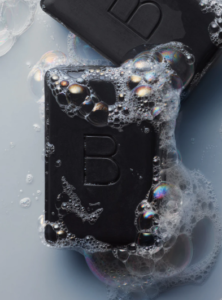
How to decide which natural deodorant to use?
The process of switching to an aluminum-free deodorant is more seamless than in previous years. Companies have really done their homework and you can now find a safe and effective deodorant. It really comes down to trying out different aluminum-free deodorants and deciding which works best for you. I will walk you through my process and how I ultimately decided on Primally Pure’s deodorant.
Native
Initially, I started using deodorant from Native. They do not use any parabens, aluminum, or sulfates. The wide variety of scents are lovely and a great option. My favorite is the Coconut and Vanilla. The deodorant glides on smoothly and I love the scents. Some other great options include the Cucumber and Mint, which is very refreshing or the Lavender and Rose has a nice floral scent. They also launch different seasonal options to change the scents up. The only downside I experienced with Native, was as the day progressed, it would clump together in little balls under my arms which was not very appealing. Truth be told, I used this brand for over a year and found that it did control any odor and I never had any break outs from it.
Schmidt’s
Due to the ability to go to a local store and purchase Schmidt’s deodorant, I thought I’d give it a try! But I found that it did not glide onto my skin smoothly. I also felt that it did not control my odor as well as Native.
Primally Pure
I then decided to try out Primally Pure’s deodorant. Va Va Voom! It is by far my favorite option out of all of the natural, safe deodorants that I have tried. Primally Pure’s natural deodorant contains a small amount of baking soda to combat odor. Formulated with kaolin clay, a powerful detoxifier and non-nano zinc oxide, it soothes away any irritation. The additional organic ingredients including grass-fed tallow, fair trade coconut oil, arrowroot powder, beeswax and essential oils make it glide on smooth, prevent clumping, and it effectively combats any odor. The Blue Tansy is my favorite and contains Blue Tansy essential oil that effectively combats inflammation and calms irritation while also soothing your skin. I also really love the Charcoal deodorant. Formulated with activated coconut charcoal, it contains additional detoxifying benefits while it also deodorizes and disinfects – great option for the man in your life.
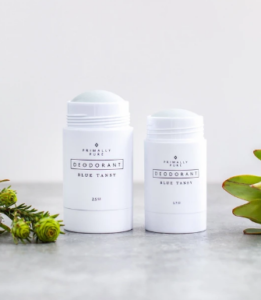
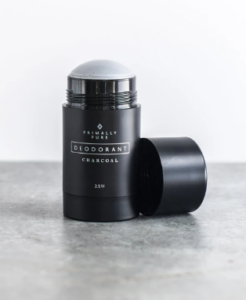
Primally Pure also offers a variety of deodorant scents and additional safe and natural products. They have a subscription option available as well to ensure you never run out of your deodorant or other favorite products!
I hope I have brought some valuable information your way regarding aluminum-based deodorant and why you should really consider making the switch to a safe, more natural option. After doing my research, the information makes me even more furious. To learn that products I purchased here in the United States, contain dangerous chemicals gets my blood boiling! Before I knew any better, I applied products while I was pregnant that likely contained parabens and phthalates. Both of these chemicals are linked to miscarriages and preterm birth – two very personal and devastating events that have affected me personally. So please, learn from my mistakes! Become your own advocate, expand your knowledge now, protect yourself and those you love, and do not be afraid to make changes!
Please reach out with any questions! Be well!
Nicole







